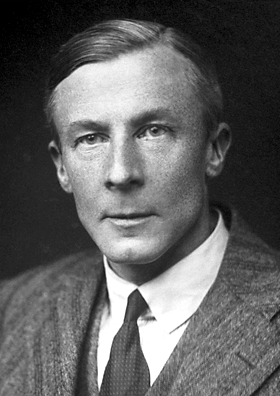Edgar Adrian facts for kids
Quick facts for kids
The Lord Adrian
|
|
|---|---|
 |
|
| 49th President of the Royal Society | |
| In office 1950–1955 |
|
| Preceded by | Sir Robert Robinson |
| Succeeded by | Sir Cyril Norman Hinshelwood |
| Personal details | |
| Born | 30 November 1889 Hampstead, London, England |
| Died | 4 August 1977 (aged 87) Cambridge, England |
| Spouse | Hester Adrian (m. 1923) |
| Children |
|
| Alma mater |
|
| Awards | Fellow of the Royal Society Nobel Prize in Physiology and Medicine (1932) Royal Medal (1934) Copley Medal (1946) Albert Medal (1953) Karl Spencer Lashley Award (1961) |
| Scientific career | |
| Fields | Biology (electrophysiology) |
| Institutions | University of Cambridge |
Edgar Douglas Adrian, 1st Baron Adrian was a very important British scientist. He studied how our nerves and brain work. He won the 1932 Nobel Prize in Physiology or Medicine for his amazing discoveries. He shared this prize with Charles Scott Sherrington. Their work helped us understand how nerve cells send electrical signals. Adrian showed that nerves either send a full signal or no signal at all. This is called the "all-or-none law."
Contents
His Early Life and Education
Edgar Douglas Adrian was born in Hampstead, London, England, on November 30, 1889. He was the youngest son of Alfred Douglas Adrian, who was a legal advisor.
He went to Westminster School and then studied Natural Sciences at Trinity College, Cambridge. He finished his studies there in 1911. In 1913, he became a fellow at Trinity College. This was because of his important research on how nerves send signals.
After getting his medical degree in 1915, he worked at St Bartholomew's Hospital in London. This was during World War I. He helped soldiers who had nerve damage and other nervous problems. Adrian returned to Cambridge as a teacher in 1919. By 1925, he started using electrical methods to study human sensory organs. These are the parts of our body that help us feel things.
Discoveries About Nerves and the Brain
Adrian continued the work of another scientist, Keith Lucas. He used special tools like a capillary electrometer and a cathode ray tube. These tools helped him make the tiny electrical signals from the nervous system much stronger. This allowed him to record the electrical signals from single nerve fibers when they were touched or stimulated.
How Nerves Send Signals
In 1928, Adrian made an accidental discovery. He found clear proof that electricity exists inside nerve cells. He published an important finding that same year. He showed that when you first touch your skin, the feeling is strong. But if you keep touching it, the feeling slowly gets weaker over time.
However, the electrical signals traveling along the nerves stay strong. What changes is how often these signals are sent. They become less frequent over time. This is why the sensation in your brain also gets weaker.
Mapping the Brain
Adrian then used these findings to study how pain signals travel. He learned how these signals are received in the brain. He also discovered how different sensory areas are spread out in the cerebral cortex of various animals. The cerebral cortex is the outer layer of the brain.
These discoveries led to the idea of a "sensory map" in the brain. This map is sometimes called the homunculus. It shows which parts of the brain are responsible for feeling sensations from different parts of the body.
Studying Brain Activity
Later, Adrian used a machine called an electroencephalogram (EEG). This machine records the electrical activity of the human brain. His work on unusual brain rhythms helped other scientists. It paved the way for more research into conditions like epilepsy and other brain diseases. Towards the end of his research career, he studied how we smell things. This is called olfaction.
Important Roles and Honors
Edgar Adrian held many important positions during his career:
- He was a professor of Physiology at the University of Cambridge from 1937 to 1951.
- He served as the President of the Royal Society from 1950 to 1955. This is a very respected scientific organization.
- He was also the Master of Trinity College, Cambridge, from 1951 to 1965.
- From 1967 to 1975, he was the Chancellor of the University of Cambridge.
In 1942, he was given the Order of Merit. This is a special honor from the British monarch. In 1955, he was made Baron Adrian. This means he became a Lord. He died in Cambridge on August 4, 1977. He was buried in Trinity College, Cambridge, which was a great honor.
His Family
On June 14, 1923, Edgar Adrian married Hester Agnes Pinsent. They had three children together: a daughter and then twins.
See also
 In Spanish: Edgar Douglas Adrian para niños
In Spanish: Edgar Douglas Adrian para niños

